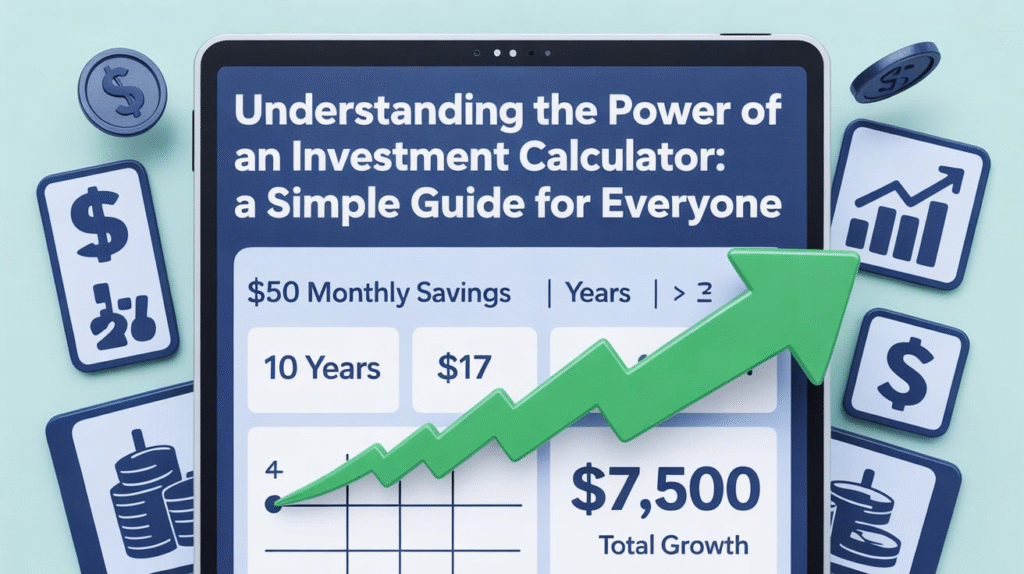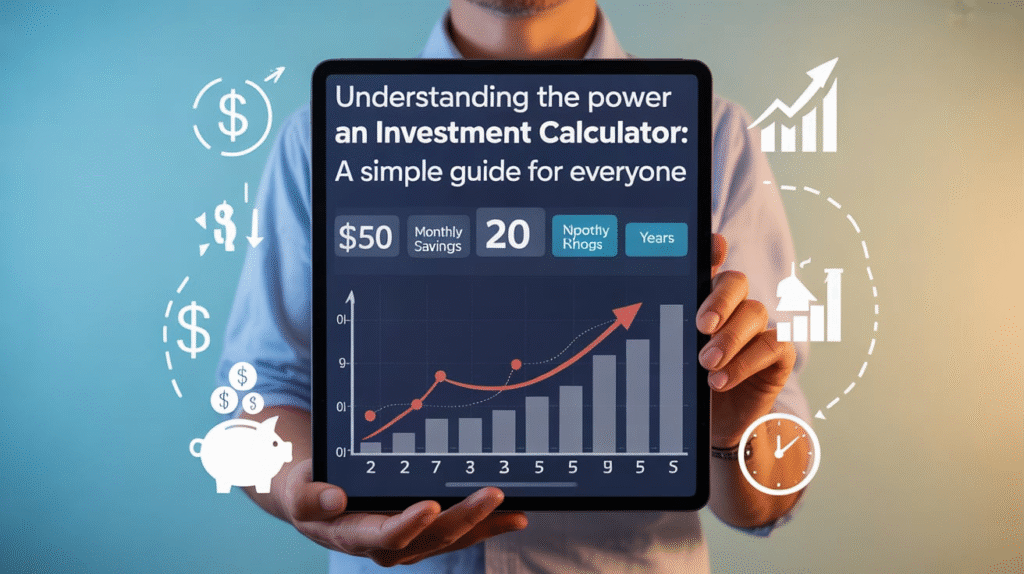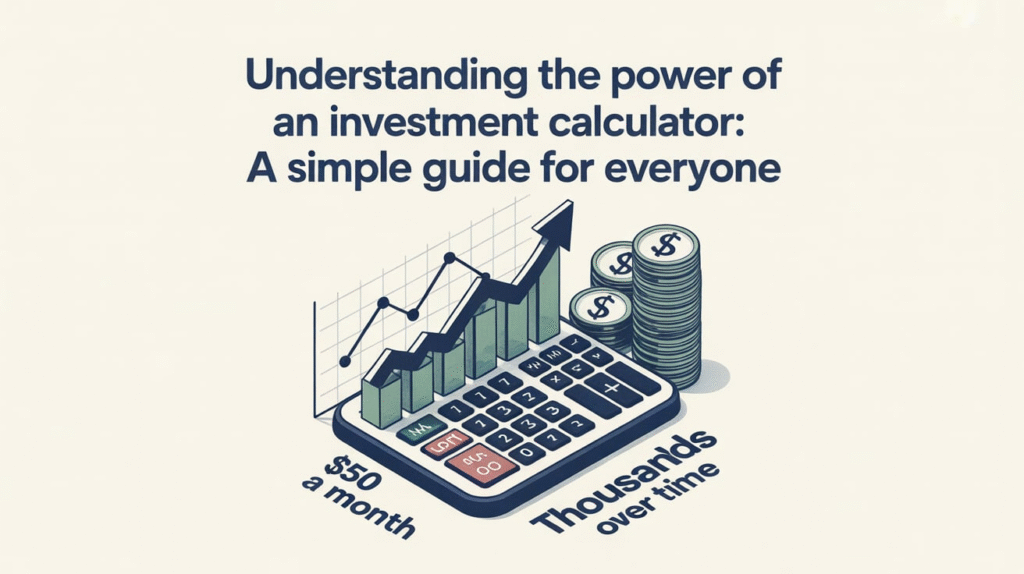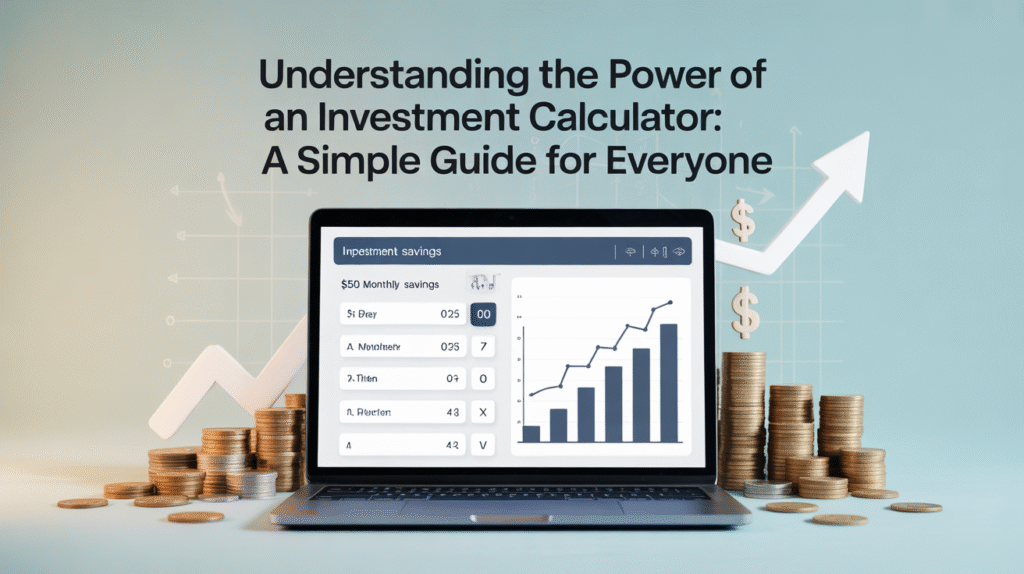Saving money is smart, but knowing how it grows is even smarter. That’s where an investment calculator comes in. It’s like a magic window that shows how your savings might grow in the future. You just enter a few numbers—how much you’ll save, how often, and for how long—and the calculator shows what your money could become.
When I first started learning about money, I had no clue how small amounts could grow. Then, I discovered an investment calculator. It helped me see that even $50 a month can turn into thousands over time. This small tool changed how I planned my goals. Let’s explore how you can use one too and make your money work smarter, not harder.
What Is an Investment Calculator?

An investment calculator is a digital tool that helps you estimate the future value of your investments. It takes into account things like how much you start with, how often you add more, and the rate of return.
For example, if you save $100 each month and expect a 6% annual return, an investment calculator will show how much that can grow in five, ten, or twenty years. The results often surprise people! You’ll see that time and consistency are powerful.
This tool removes the guesswork. You don’t have to be a math expert. It uses formulas like compound interest to give quick, clear answers.
How Does an Investment Calculator Work?

An investment calculator uses a simple formula to project your money’s growth. The basic idea is compound interest, which means you earn interest on your interest. Over time, this creates powerful results.
Here’s the formula behind the scenes:
Future Value = P(1 + r/n)^(nt)
Where:
- P is your starting amount.
- r is the annual interest rate.
- n is how often interest compounds.
- t is the time in years.
Most people don’t need to remember this formula because the calculator does it for you. Just type your details in, hit “calculate,” and get your result in seconds.
Why Time Is Your Best Friend in Investing
The earlier you start investing, the better. That’s because time gives your money a chance to grow through compounding. Even small amounts can become big numbers when you let them sit and grow.
For instance, if you invest $100 monthly at 7% interest for 30 years, you’ll end up with more than $120,000—even though you only invested $36,000. The difference is the magic of time.
An investment calculator helps you visualize this clearly. It shows why waiting even five years to start could mean losing thousands in potential growth. The lesson? Start now, no matter how small your amount.
Setting Your Financial Goals with an Investment Calculator

You can use an investment calculator to plan almost any goal—big or small. Want to buy a house? Save for your child’s college? Retire early? The tool helps you figure out how much you need to save each month to reach that target.
Start by entering your goal amount, timeline, and expected return rate. The calculator then shows what you need to invest regularly to meet your target.
This makes goal planning easy and motivating. You’ll see exactly what’s possible with your budget and how consistent saving adds up over time.
Types of Investment Calculators You Can Use
Not all calculators are the same. Depending on your needs, you can choose from several kinds:
- Basic Investment Calculator – Estimates how your money grows over time.
- Compound Interest Calculator – Focuses on interest-on-interest growth.
- Retirement Calculator – Helps plan long-term savings and income needs.
- Stock Investment Calculator – Estimates returns based on stock growth rates.
- Mutual Fund Calculator – Shows possible returns from funds or SIPs (Systematic Investment Plans).
Each one uses similar math but focuses on different goals. The best part is, most of them are free online and take seconds to use.
How to Use an Investment Calculator Step-by-Step
Using an investment calculator is simple. Follow these steps:
- Enter your starting amount. This is how much you’re investing right now.
- Add your monthly or yearly contributions. This is the extra money you’ll invest regularly.
- Choose an interest rate. Use a realistic rate based on your investment type.
- Set the time frame. This could be 5 years, 10 years, or even 30 years.
- Click calculate! The tool instantly shows your total future value and earnings.
You can tweak the numbers anytime to test different scenarios. It’s a great way to see what happens if you save more, invest longer, or earn a higher return.
Real-Life Example of How It Works
Let’s look at a real example.
Emma saves $200 a month in a fund that earns 8% yearly. She plans to invest for 20 years. When she enters these numbers into an investment calculator, she sees a future value of about $118,000. But here’s the amazing part—she only invested $48,000 herself. The rest, over $70,000, came from compound growth!
This shows why consistent investing pays off. It also proves how small habits can lead to life-changing results over time.
Understanding Compound Interest Through the Calculator
Compound interest is the secret sauce behind investing. It means your interest earns more interest. Imagine planting a tree that grows more trees every year. That’s how compounding works!
An investment calculator helps you see this effect clearly. It separates your total contributions from your earned interest. You’ll notice that in the early years, growth seems slow. But later, it speeds up fast as your money multiplies.
This is why financial experts often say, “It’s not timing the market—it’s time in the market.” Using a calculator helps you understand that deeply.
Choosing the Right Investment Calculator for You
There are hundreds of calculators online, but not all are equal. Some are simple, while others have more detailed options. When choosing one, look for:
- Accuracy: It should use the compound interest formula.
- Customization: You should be able to change rates, time, and contributions easily.
- Clarity: It should show results in a clear chart or graph.
- Security: Use trusted financial sites or apps to keep your data safe.
Some popular options include calculators from NerdWallet, Bankrate, and Investor.gov. You can also use spreadsheet tools like Google Sheets or Excel to create your own.
How an Investment Calculator Builds Financial Confidence
Many people feel nervous about investing because they don’t understand how growth happens. Seeing your potential returns makes everything more real and less scary.
When you use an investment calculator, you can test ideas safely. You can see what happens if you invest more, start earlier, or pick different interest rates. This builds confidence and helps you make smarter decisions.
It’s not just about numbers—it’s about peace of mind. Knowing you have a plan helps you feel more in control of your future.
Common Mistakes to Avoid When Using an Investment Calculator
Even though an investment calculator is simple, people sometimes make mistakes that lead to confusing results. Here are a few to avoid:
- Using unrealistic interest rates. Don’t expect 15% yearly forever—it’s not practical.
- Ignoring inflation. Prices rise over time, so plan accordingly.
- Not adding contributions. Regular investing is key to big growth.
- Forgetting taxes or fees. Some investments come with small costs.
If you keep these points in mind, your results will be more accurate and useful for real-life planning.
Personal Insight: How I Used an Investment Calculator
When I first tried an investment calculator, I didn’t expect much. I just wanted to know how my $100 savings habit might grow. The result amazed me—it could reach over $40,000 in 25 years! That one number motivated me to start investing seriously.
Now, I use a calculator every few months to track progress. It helps me stay focused and excited about my goals. If you’ve never tried one, do it today—you might discover the same motivation I did.
The Bigger Picture: Building Wealth with Small Steps
An investment calculator is more than just a math tool. It teaches patience, discipline, and long-term thinking. You don’t need a big salary to start building wealth—you just need consistency.
By seeing your growth visually, you’ll be inspired to keep going. The calculator turns invisible progress into something you can see and celebrate. Over time, that small spark of motivation can change your whole financial future.
Frequently Asked Questions (FAQs)
1. What is the main purpose of an investment calculator?
It helps you estimate how your money will grow over time based on your inputs—like savings, rate, and time.
2. Are investment calculators accurate?
They’re very close, but remember—they give estimates. Real returns may differ based on market changes and fees.
3. Can I use an investment calculator for retirement planning?
Yes! A retirement calculator is a type of investment calculator designed for long-term savings goals.
4. What’s the best interest rate to use in an investment calculator?
Use realistic rates. For example, 5–8% is typical for stock-based investments. For safer ones, use 2–4%.
5. Do I need special software to use one?
No. Most investment calculators are free online. You can use them on your phone or computer anytime.
6. How often should I check my results?
Every few months is great. Update your numbers if your savings habits or goals change.
Conclusion: Your Money Deserves a Plan
An investment calculator isn’t just a digital tool—it’s a guide for your financial journey. It shows how small, steady actions can grow into something amazing. Whether you’re saving for a home, college, or retirement, it helps you plan wisely.
Start today. Enter your numbers, explore different scenarios, and watch how your future takes shape. Remember, the best time to invest was yesterday—the next best time is now. Your financial freedom begins with one simple step and an investment calculator to guide the way.



